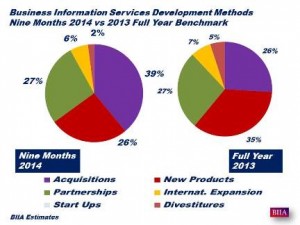A top information technology research company advises that riding the wave of applying advanced analytics to big data – to identify everything from opportunities to risk – should be global businesses’ top priority.
Gartner says the booming trend of using advanced analytics within business intelligence (BI) is being fuelled by the need to make analysis accessible to more firms, and broaden insight to provide businesses performance reports.
 BIIA (Business Information Industry Association) has been tracking this trend for two years, and found that advanced analytics – also known as predictive analytics – is now the fastest-growing segment within the business information industry. In terms of new products being introduced into the Business Intelligence sector, analytics have taken the lead, while information platforms have taken second place. Since analytics, platforms, mobile apps and big data generally go hand-in-hand, combined solutions now make up more than 50% of new products being introduced into the market (see top chart).
BIIA (Business Information Industry Association) has been tracking this trend for two years, and found that advanced analytics – also known as predictive analytics – is now the fastest-growing segment within the business information industry. In terms of new products being introduced into the Business Intelligence sector, analytics have taken the lead, while information platforms have taken second place. Since analytics, platforms, mobile apps and big data generally go hand-in-hand, combined solutions now make up more than 50% of new products being introduced into the market (see top chart).
The development of analytical services takes time, thus BIIA has observed that the fastest route to gaining this critical expertise is through acquisitions and partnerships (see bottom chart).
 Both of these charts illustrate of how analytics are one of the most rapidly-expanding areas within business intelligence services today, with analytics software sales surpassing the billion dollar mark last year.
Both of these charts illustrate of how analytics are one of the most rapidly-expanding areas within business intelligence services today, with analytics software sales surpassing the billion dollar mark last year.
The key driver is ‘big data’, credited for a surge in advanced analytics tools coming onto market for business use, after having existed quietly in the background for two decades, mainly in the fields of marketing and risk. New modern-day applications for analysis include better decision-making and improved business outcomes.
Essentially, the market is experiencing a migration away from traditional BI that addresses descriptive analysis (what happened) to advanced analytics aimed at providing answers to questions like ‘why’, ‘what will happen’, and ‘how should we address it?’
Over and above providing a general summary of business data, advanced analytics is helping to deliver deeper data knowledge and granular data analysis, allowing for data-driven decision-making that can boost business outcomes.
The quest to extract value from business data is opening up new fields of expertise, with data scientists becoming increasingly sought after as they draw tangible benefits for businesses by converting raw data into opportunities for enhanced commercial performance and competitive advantage.
With salaries at an average of over $100,000 per annum according to career database Glassdoor, data scientists aren’t cheap to hire, but used correctly, their input can reap substantial rewards.
One of the key applications companies are using them for is to work with their big data to enhance their customers’ experiences.
As reported by Worldbox earlier this year, Gartner’s last global big data survey revealed more than two thirds of respondents were using big data to improve users’ experiences; a facet that ranked as one of the top applications for BI for the third successive year.
Other top applications of business intelligence analysis of big data includes how to acquire new customers, how to improve cross-selling, information, route optimisation and failure prediction.
While data scientists are not business analysts, they do have the capability to derive mathematical models from data that can bring real business benefits, Gartner added.
One alternative to hiring data scientists is the rise of visual analytics: a BI tool designed for business users, rather than people with computer science degrees, with the goal of making data as accessible to the layman as it is to the scientist.
Visual analytics let businesses identify trends and gain insights by displaying the data in a visually appealing and simplified manner, even assembling dashboards and charts into interactive presentations.
Data analysis needs of small businesses and large corporate companies may often be similar, but visual tools aimed at SMEs provide a lower and more accessible entry point that no small business should overlook, experts advise.
 This story is provided by Worldbox Business Intelligence.
This story is provided by Worldbox Business Intelligence.






















